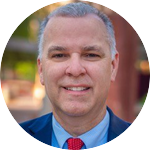
In October 2021, I retired as city manager of Phoenix, Arizona, the largest council-manager city in the United States. After serving eight years as the city manager and a total of 28 years in Phoenix government, I was exhausted—physically, mentally, and emotionally—and needed time to restore myself. To those who asked about my decision, I said I’ve still got tread on my tires, but I don’t have any fuel left in my tank.
My 28 years felt like a sprint up a mountain. I began working in the Phoenix local government almost literally in the mailroom. As a management intern in 1993, I responded to letters and phone calls to the city manager, worked on budgeting projects, staffed citizen committees, and took minutes at council sessions. I took on positions of increasing responsibility and 20 years later, in 2013, was named interim city manager. In 2014, the city council made it permanent, placing me as chief executive of an organization with 15,000 employees and a $5.6 billion budget.
The lingering effects of the Great Recession were still felt in 2014, and I worked with the council to close a $39 million budget deficit. Over the next eight years, we restored services and employee pay that had been cut to balance the budget. We wrestled to better fund our pension system, participated in the national reckoning on race and policing, renovated our NBA arena, and responded to the pandemic—all while serving 1.7 million residents. The responsibility was constant and the problems to solve were exciting. Phoenix was named America’s most innovative city by Governing in 2017, and the only city in the Forbes 500 list of best places to work in 2020.
By 2021, we had a $30 million surplus and were positioned to ask the voters for the first new general obligation bond capital program in 17 years. Five years past my retirement eligibility date, I had accomplished most of what I had set out to do and it was time to leave the work to the team I had built.
Before doing anything else, I knew I had to take time to refill my tank. The constant drumbeat of people, challenges, and solution-finding left me dry. So here’s what I did:
Engaged an Executive Coach
I signed on with an executive coach to help clarify my move into the next season of life. Previously I had viewed executive coaching only as a salvage mission for failing managers and executives. Was I wrong! My coach opened my eyes to the power of personal work in leadership improvement and the importance of professional guidance. She helped me face my fears and hopes, strengths and weaknesses, and blind spots and vision. I could identify more clearly why I love leadership and how to continue stretching my skills.
Hired a Strength Trainer
I had always been active—running, playing basketball, doing the stairmaster at the YMCA—but never any serious weight conditioning. And particularly during my time as city manager, I found myself less active than I liked. I found a trainer and learned to lift weights and build flexibility correctly.
Attended a Leadership Seminar
I was the sole government professional at the week-long event, and I found that mixing with people from outside government was energizing. I learned that challenges of city management are similar to those leaders face in other businesses, although some issues—like public involvement, elected politics, and public salary disclosures—are truly baffling to non-government leaders. We talked about life, inspiration, and leadership, not government minutiae. I gained a new appreciation for the important work of confronting the issues that prevent us from bringing our whole selves to leadership.
Learned to Meditate
At the suggestion of my executive coach, I downloaded an app and began a regular practice of mindfulness every day. Working on breathing, intentionality, and setting purpose became a regular way to start each morning. The app made it easy and always accessible.
Read Widely
I went well beyond my typical government reading routine. Hamnet, a fictional imagining of William Shakespeare’s family life, took me back to my early career as an English teacher. I read Dopesick after watching the TV series. From there, I picked up Deaths of Despair and the Future of Capitalism and the fictional Demon Copperhead. These books filled in the gaps in my knowledge about the epidemic of opioids, corrupt policymaking, and ineffective public health resources that have left us with an ongoing national drug crisis. I dove into the leadership writings of Henry Cloud and John Townsend, books on racial equity, and detours with Malcolm Gladwell and a biography about Tom Petty. (I also got mildly obsessed with his music). It was a break from three decades of city council packets and public policy briefs and it was fun.
Explored My City
I hiked Phoenix’s amazing mountain preserves to peaks and desert vistas I never knew existed. I enjoyed sporting events at the downtown arena for which I had negotiated a remodel. I went to concerts in the park and took day hikes to the most beautiful parts of the city that I hadn’t made time to enjoy.
Re-engaged with Family and Friends
As city manager, I found myself constantly distracted and distant from those closest to me. Even on vacation, the stress of the job was always a low hum in the back of my brain. So I reconnected. I went to breakfast and lunch during the week with friends and acquaintances. I called up former colleagues to talk about how they were doing. I spoke to new city managers and facilitated seminars, sharing about my experience and encouraging others to talk about theirs. I took time to actually be present for weddings and funerals to honor and celebrate people in my community. The connection with others’ lives, hopes, and dreams was a refreshing reminder of the goodness in the world and the joys and sorrows of everyday life that I had detached from with the stress of managing a city.
Reflecting on this list, it’s easy to see now that each of these were accessible while I was a city manager. The fuel these experiences gave me would have been sustaining. I can’t pretend that I could have done all of them, of course. The unstructured time of retirement is a luxury that working city managers don’t have. But making any one of these activities a higher priority would have raised my quality of life. What I learned in retirement is that these activities can be additive, not subtractive, to my days, and that they can take relatively short periods of time. They can’t all be done simultaneously, but the key is to start doing something that refills the tank.
After taking this time to refill my tank, I went back to work, first as an advisor in a private sector firm and most recently as an executive director of a metropolitan planning organization. But I have continued many of these adopted practices, working with a personal trainer, meditating, reading more broadly, and talking to people all over the country. I prioritize my family engagement and getting out on the weekends. I even take an occasional 4:00 p.m. hike on a weekday.
With the perspective gained during a year away from being a city manager, I encourage local government managers and young professionals to look for small steps to create time for mental, physical, emotional, and spiritual growth. Yes, these jobs are incredibly demanding and doing them well takes lots of time and energy. But the practice of finding one thing you want to learn about or invest time in can greatly enhance your quality of life and increase the fuel in your tank. As the saying goes, a wise person learns from the experience of others. My hope is that something from my experience can increase the wisdom of those working in the profession every day.

ED ZUERCHER is executive director at Maricopa Association of Governments. He retired as city manager of Phoenix, Arizona, in October 2021.
New, Reduced Membership Dues
A new, reduced dues rate is available for CAOs/ACAOs, along with additional discounts for those in smaller communities, has been implemented. Learn more and be sure to join or renew today!
